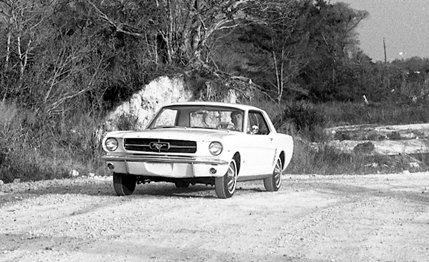Even if the “quick” steering is a little slow, the road feel is quite good, the power steering and its reduced feedback notwithstanding. Reactions to road unevenness in the wheel are very slight, and vibrations are not so much felt as hinted at. And if the response is lagging, the car is obedient enough once the front wheels have been pointed in the right direction.
Rear suspension is also based on the standard Falcon, with different forward spring mountings and beefed-up rubber bump stops. The leaf springs which were adequate with Falcon engine torque began to give trouble with axle tramp and spring wind-up during development with the 289-cu in Mustang V-8, so the springs were beefed up too. But both Matthias and Prendergast remain adamant that there’s no need for torque rods or any other aid to axle location. We are not perfectly in agreement with this, as leaf springs tend to be flexible in directions other than intended, and if they are to be made rigid enough for a high-performance car, it’s difficult to obtain spring rates low enough for acceptable ride comfort. Evidence of this difficulty shows up in the Mustang on the first gentle bumps. The front springs oscillate at a much higher frequency than the rear ones, giving the sort of ride one gets in a small boat hitting choppy waves head-on. The poop stays more or less put while the bow is bobbing in excitement. On the Mustang, the front and rear suspensions (in standard form) are absolutely not attuned to each other.
The good thing about leaf springs is that any change in their behavior is gradual, and consequently easily controlled and corrected by the driver. And from the manufacturer’s point of view, they make for a very inexpensive rear end. The shock absorbers are sharply angled, but the Ford press releases are incorrect in stating that this type of mounting reduces side sway. It has no effect on sway whatsoever—its value lies in reducing lateral axle movements in relation to the chassis.
|
|
We did not get an opportunity to test the independent rear suspension. Its design resembles that of the Mustang I (C/D December 1962) in having four transverse and semi-trailing links, with narrow-diameter inclined coil springs. This suspension is of very advanced design (by Roy Lunn) and modified only by Ford Division’s requirements for installation on the production Mustang. The wheels can be given adequate wheel travel and still have negative camber at all times, and spring rates can be set to suit a wide variety of driving conditions.
Roll center height with the independent rear suspension will probably be about 5 in, as on the Mustang I, as against 7.5 in on the rigid-axle model. Mustangs fitted with the independent rear end will have modified front suspension setups to raise the roll center from 1.7 in to 2.6 in.
Even in standard form the Mustang has less nosedive than any other American-built Ford passenger car, but this is due more to the low center of gravity than to improvements in suspension design. The low center of gravity also contributes to reduce body roll, but on a 200-ft diameter circle, the car leans over just like a little Thunderbird. On high-speed curves, the roll is not objectionable.
|
|
We would not have expected the Mustang with its standard chassis to handle well. As a matter of fact, it is not bad. The car is so well balanced that it can be driven very hard and remain fairly stable and well in control. It has some initial understeer, seems perfectly neutral at normal speeds, and ultimately oversteers.
The basic engine for the Mustang is the 170-cu in Falcon six—a piece of machinery about as exciting as a dish of babyfood. It develops 101 bhp at 4400 rpm and has a maximum torque of 156 lbs-ft at 2400 rpm, and can be combined with Ford’s three-speed manual transmission with non-synchro first gear, Ford’s four-speed manual all-synchro gearbox, or the new three-speed Cruise-O-Matic. The 200-cu in six is not available on the Mustang, neither is the 221-cu in V-8; the next step is the 260-cu in Fairlane engine, which develops 164 bhp at 4400 rpm and has a maximum torque of 258 lbs-ft at 2200 rpm with a compression ratio of 8.8-to-one. Our test car had the 289-cu in version, with 9.0-to-one compression, four-barrel carburetor, and 210 horsepower.
What most enthusiasts will want is the high-performance version of the 289-cu in engine, which differs considerably from the standard 289. The Fairlane series is derived in its entirety from a lightweight cast iron V-8 designed by George F. Stirrat in 1958/59 and introduced in 221-cu in form in 1961. It weighed only 450 pounds complete, and had very compact dimensions: 8.93 in high, 16.36 in wide, and 20.84 in long.
View Photos
View Photos


Leave a Reply